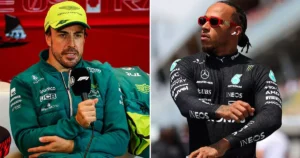Russell, Hamilton’s Mercedes teammate, had been chasing Alonso for P6 in the final stages of the race at Albert Park, but as Alonso slowed heading into Turn 6, Russell lost control and collided with the wall, bringing his W15 to a halt in the middle of the track and ending the race under the Virtual Safety Car.
The stewards ruled Alonso guilty of “potentially dangerous” driving and awarded a drive-through penalty of 20 seconds plus three points on his FIA Super Licence, dropping him two places to eighth in the final classification.

However, Palmer, in a piece for the Formula 1 website, compared this incident to one at the 2023 Abu Dhabi Grand Prix, where Alonso exited the pit lane and then slowed in front of Hamilton in a battle for DRS, as a similar instance of gamesmanship, but Alonso received no punishment, demonstrating a significant disparity in how the stewards reacted to these incidents.
Palmer believes that the spectacular circumstances of the incident played a significant factor in Alonso’s harsh punishment in Melbourne.
“Was this unsafe, unpredictable driving the cause of an accident for George Russell? First, let’s see if it was erratic driving,” Palmer said as he rewatched the Alonso-Russell clash.
“We jump on-board with Fernando going back to George Russell; you can hear that Alonso was a touch unsteady.
“As we approach Turn 6, he backs off the throttle, then re-engages it and enters the bend. That is unusual, and Russell caught him at a much faster speed than anyone would expect while following another automobile.
“Certainly, this was odd. Alonso had not done that in the preceding 56 laps, nor had anyone else. It’s not something the driver behind would have expected.
“So there’s an adjustment from Alonso. Why did he do this? Because right after this is the circuit’s largest overtaking area, followed by DRS and a long run to Turns 9 and 10, where Russell had previously been near.
“And he’s trying to play games with Russell, trying to throw the Mercedes driver off, and it’s backfired, and the Mercedes driver has crashed into a wall. So, undoubtedly, there is a case for erratic driving. It appears to be erratic driving.
“The second question is: Has erratic driving always been punished? The answer is “no.”
“Because Fernando Alonso finished ahead of Lewis Hamilton in Abu Dhabi just three races ago, doing the same thing.
“Alonso comes out of the pits, Hamilton is on a flying lap, a Mercedes behind the Aston Martin, and he backs off well before the braking zone, forcing Hamilton to back up just to stay behind Alonso.” They are playing DRS games here, which is similar to what Alonso tried in Melbourne.
“Most importantly, there was no penalty. Fernando Alonso received no ramifications for this three races ago, but in Melbourne, he was issued a large penalty, a drive-through, which lost him 20 seconds of racing time, which is more than we’ve seen for many accidents previously.
“Alonso’s driving is irregular, definitely. But is that compatible with what has happened previously? The answer is no in this circumstance. So, whether they like it or not, the stewards have looked at the outcome of George Russell hitting the barriers and ending up in the middle of the track, making the collision appear more dramatic than it was.
“And that, I’m sure, is the reason that Alonso has been investigated as thoroughly and deemed punishable in this instance.”
Palmer also believes Russell should shoulder some, if not all, of the blame for this incident, arguing that there was enough distance between him and Alonso heading into Turn 6 to make this a safe driving issue, rather than Russell losing control of the W15 in Alonso’s foul air.
“There is a decent amount of space between the two cars,” Palmer continued. “Alonso is now driving recklessly, and this has been confirmed. But is this dangerous? Because there is a significant difference between Alonso’s and Russell’s cars.
“And this is not, I believe, a typical brake test in which the automobile behind must apply the brakes to avoid colliding with the car in front.
“It’s simply a case of him getting too close, going at full racing speed, and catching some dirty air, which causes George to oversteer, which he corrects and ends up in the wall.”
“Overall, I just can’t help but feel, watching it from Russell’s perspective, that yes, Alonso slows down, yes, it is technically erratic, and that gives the stewards certainly reason to penalize him; it’s an inconsistent penalty, but technically, according to this particular circumstance, it’s difficult for Alonso to argue with it, but there is enough space between the two cars.”
“And as he’s coming in, was there anything else Russell could do, other than blast ahead at full speed, stop a little earlier, but only in a way that was identical to what he’d done previously in the race, and then end up in the barriers? George needs to take at least some of the blame, if not all of it.
“It’s a hazy picture, but you know that Alonso does operate in these grey areas; he does it all the time, whether it’s last year in Abu Dhabi, or I believe cheekily causing a yellow flag in Baku qualifying a few years ago to prevent people from improving; there are numerous instances where Fernando Alonso operates in these grey areas.
“There is probably an argument for penalizing him. In my perspective, it’s a tad harsh on Fernando. I don’t think what he did was very unsafe; I believe there was enough room between the two automobiles for him to back off somewhat.
“And the two automobiles were never near to colliding; there was always plenty of room. It’s just a dirty air issue, and we’re opening a bag of worms with that one.”

Leave a Reply